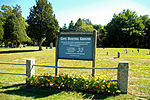Edward Penniman House and Barn
Barns on the National Register of Historic Places in MassachusettsEastham, MassachusettsHouses completed in 1867Houses on the National Register of Historic Places in Barnstable County, MassachusettsNRHP infobox with nocat ... and 3 more
National Register of Historic Places in Cape Cod National SeashoreSecond Empire architecture in MassachusettsWikipedia page with obscure subdivision

The Edward Penniman House and Barn is a historic site in Eastham, Massachusetts, on Fort Hill, which is currently protected by the Cape Cod National Seashore and home to Indian Rock. The house was built in 1868 and added to the National Register of Historic Places in 1976.
Excerpt from the Wikipedia article Edward Penniman House and Barn (License: CC BY-SA 3.0, Authors, Images).Edward Penniman House and Barn
Fort Hill Trail,
Geographical coordinates (GPS) Address External links Nearby Places Show on map
Geographical coordinates (GPS)
| Latitude | Longitude |
|---|---|
| N 41.818472222222 ° | E -69.965666666667 ° |
Address
Penniman House
Fort Hill Trail
02642
Massachusetts, United States
Open on Google Maps









